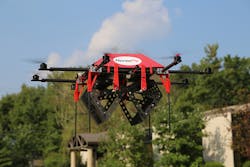Drone deliveries may be grounded before ever lifting off
When the Federal Aviation Administration (FAA) issued its framework of regulations that would limit unmanned aircraft systems (UAS), i.e. drones, it was immediately perceived as a major setback for Amazon, which desires to create a fleet of package delivery drones.
It is also a setback, though, for others in the trucking and shipping industries, including DHL which started testing drones last year. Some view delivery drones as a way to boost driver productivity, offset some of the driver shortage, and improve customer service with quicker delivery times.
Amp Trucks, which has been developing its own delivery drone called the Horsefly, could be one of those impacted by the ruling. Specifically, the provision that the commercial drone not carry external cargo.
“The FAA guidelines require line of sight and also do not permit external loads (cargo),” Steve Burns, CEO of Amp Trucks, told Fleet Owner. “Because we have a driver close by, we can live with the line of sight requirement during the early years. Working with [the University of Cinncinatti], we feel can demonstrate to the FAA that the HorseFly’s control system is very robust and can assure stability while flying empty or with a load. The waiver we are seeking from the FAA to test outdoors also requests the ability to test with external loads.”
In its proposal, FAA noted the possibilities of allowing “external loads.”
“The FAA considered allowing small unmanned aircraft to conduct external-load operations and to tow other aircraft or objects,” it wrote. These operations involve a greater level of public risk due to the dynamic nature of external-load configurations and inherent risks associated with the flight characteristics of a load that is carried, or extends, outside the aircraft fuselage and may be jettisonable. These types of operations may also involve evaluation of the aircraft frame for safety performance impacts, which may require airworthiness certification.
“Given the risks associated with external load and towing operations, the FAA cannot find that a certification is not required. However, the FAA invites comments, with supporting documentation, on whether external-load UAS operations and towing UAS operations should be permitted, whether they would require airworthiness certification, whether they would require higher levels of airman certification, whether they would require additional operational limitations, and on other relevant issues,” it added.
According to the FAA, the proposed rule would require the UAS to be under 55 lbs. The rule would also require:
- An operator must always see and avoid manned aircraft. If there is a risk of collision, the UAS operator must be the first to maneuver away.
- The operator must discontinue the flight when continuing would pose a hazard to other aircraft, people or property.
- An operator must assess weather conditions, airspace restrictions and the location of people to lessen risks if he or she loses control of the UAS.
- A small UAS may not fly over people, except those directly involved with the flight.
- Flights should be limited to 500 ft. altitude and no faster than 100 mph.
- Operators must stay out of airport flight paths and restricted airspace areas, and obey any FAA Temporary Flight Restrictions (TFRs).
Burns said successful indoor testing of the Horsefly has been. The eight-rotor drone is being developed in conjunction with the University of Cincinnati’s Dept. of Aerospace Engineering and Engineering Mechanics. Burns explained that the drone sits on top of a vehicle, charging when not in use. A driver can than walk back into the cargo area, pick up a package and pass it up through the portal to the drone, which clamps onto the box (up to 10 lbs.), reads the barcode to locate the delivery address, and then flies off.
While the drone is making its delivery, the driver can get back into the driver’s seat and go on to his next delivery, improving efficiency. When the drone has completed its task, it locates the current location of the vehicle and returns to the portal atop the roof, ready for its next delivery.
Burns said that, based on his understanding of the proposal, it would limit the ability of companies such as Amazon, but might ultimately work for others.
“Our understanding is that Amazon would like to dispatch delivery drones from a central warehouse directly to the recipient’s doorstep. That type of architecture does appear to be in contrast to the FAA guidelines,” he said. “However, truck-based local delivery companies such as the Post Office could easily remain in sight of the HorseFly from a vehicle at the mailbox in order to watch the delivery at the door step by the HorseFly.”
FAA is accepting comments on the proposal until April 24, but Amazon’s hopes for U.S. based drone delivery service may hinge on changes.
“The FAA needs to begin and expeditiously complete the formal process to address the needs of our business, and ultimately our customers,” Paul Misener, Amazon’s vice president for global policy, told Fortune in a statement. “We are committed to realizing our vision for Prime Air and are prepared to deploy where we have the regulatory support we need.”
According to the Fortune article, other companies such as Domino’s Pizza and Google are considering the use of drones. UPS is also evaluating the potential for drone delivery, according to CNBC, which interviewed Myron Gray, UPS president of U.S. operations, back in August 2014.
When asked about the potential for using delivery drones, Gray told CNBC’s Kelly Evans. “We’re closely evaluating drone usage as well as other means of delivery. We don’t see it happening in the near future, but there might, perhaps, be a place for it sometime down the road.”
You can watch the entire interview with Gray here: http://video.cnbc.com/gallery/?video=3000298560.
